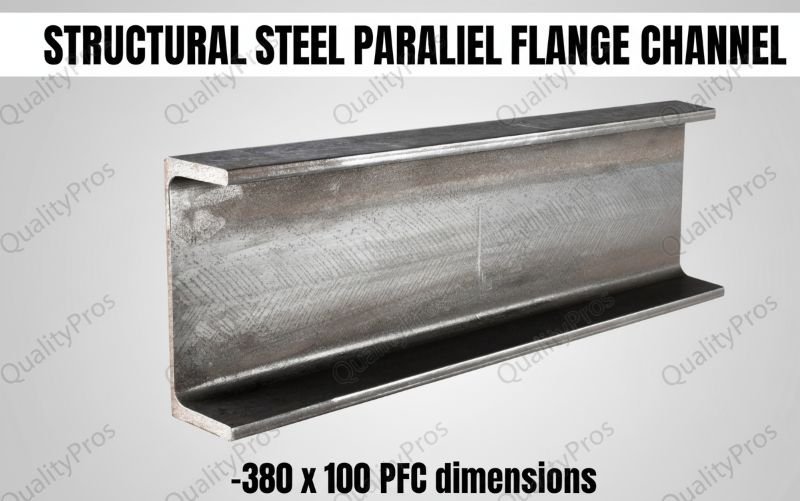380 x 100 PFC dimensions
teel channels are the unsung heroes of modern construction, and the 380 x 100 Parallel Flange Channel (PFC) stands out for its robust design and versatility. Known as a “C-section,” this profile combines specific dimensions to deliver exceptional strength for demanding structural applications. Let’s break down its dimensional details and why they matter.
| Web thickness (WT) | 10 mm |
| Flange thickness (FT) | 17.5 mm |
| Width (F) | 100 mm |
| Height (w) | 380 mm |
| Weight (Kg/Meter) | 55.2 |
| Root Radius | 14 mm |

Section Properties & Structural Performance
Beyond basic dimensions, the 380 x 100 PFC’s engineering properties dictate its load-bearing capabilities:
- Cross-Sectional Area: 7,030 mm²
- Moment of Inertia (Ixx): 152 million mm⁴ (resistance to bending about the major axis)
- Moment of Inertia (Iyy): 6.48 million mm⁴ (minor axis stiffness)
- Torsion Constant (J): 472,000 mm⁴
- Plastic Modulus (Yp): 161,000 mm³
The stark contrast between Ixx and Iyy highlights the channel’s directional strength—ideal for vertical loads in beams or columns.
🏗️ Applications Leveraging Key Dimensions
The 380 x 100 PFC’s geometry makes it indispensable for:
- Lintels & Openings: The 100 mm flange width provides a stable bearing surface for masonry above doors/windows.
- Cavity Wall Supports: Two PFCs bolted back-to-back (spaced 100 mm apart) support dual-wall layers efficiently.
- Heavy-Duty Framing: The 380 mm depth offers high rigidity for floor joists and long-span beams.
- Industrial Columns: The 17.5 mm flange thickness resists buckling under compressive loads.
⚠️ Manufacturing Notes & Discrepancies
- Material Grades: Typically S355J0 mild steel (yield strength ≥355 MPa).
- Process: Hot-rolled to AS 4100-1998 or BS 4-1:2005 standards.
- Weight Variation: Some sources list 54.0 kg/m 9, others 55.2 kg/m. This reflects regional tolerances.
